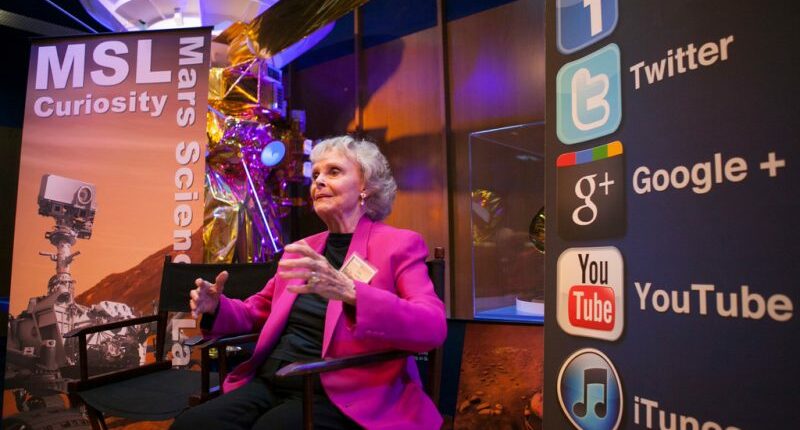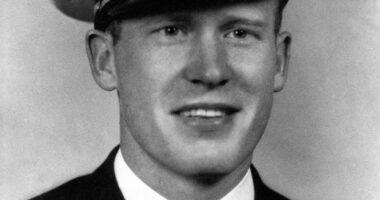Share this @internewscast.com

LOS ANGELES — June Lockhart, who graced television screens as a beloved maternal figure in both “Lassie” and “Lost In Space,” has passed away at the age of 100. Her passing was confirmed by family spokesman Lyle Gregory, a close friend for four decades, who announced that Lockhart died peacefully of natural causes at her Santa Monica home on Thursday.
“She remained in good spirits until the very end, staying engaged with the world through the New York Times and LA Times,” Gregory shared. “Staying informed on current events was very important to her.”
Lockhart, born into a family with acting roots through her father, the well-known character actor Gene Lockhart, embarked on her career in film as a young actress often cast in ingenue roles. However, it was television that elevated her to stardom.
From 1958 to 1964, she captured hearts as Ruth Martin, the nurturing mother figure to the orphaned Timmy, played by Jon Provost, on the widely loved CBS series “Lassie.” She then journeyed into the cosmos from 1965 to 1968, portraying the matriarch of the Robinson family on the adventurous CBS show “Lost in Space.”
June Lockhart’s portrayal of kind and caring mothers left a lasting impression on audiences, particularly young viewers of the time. Her enduring appeal was evident as baby boomers later flocked to nostalgia conventions, eager to meet her and collect autographed photographs that celebrated her iconic roles.
Her portrayals of warm, compassionate mothers endeared her to young viewers, and decades later baby boomers flocked to nostalgia conventions to meet Lockhart and buy her autographed photos.
Offscreen, Lockhart insisted, she was nothing like the women she portrayed.
“I must quote Dan Rather,” she said in a 1994 interview. “I can control my reputation, but not my image, because my image is how you see me.
“I love rock ‘n’ roll and going to the concerts. I have driven Army tanks and flown in hot air balloons. And I go plane-gliding — the ones with no motors. I do a lot of things that don’t go with my image.”
Early in her career, Lockhart appeared in numerous films. Among them: “All This and Heaven Too,” “Adam Had Four Sons,” “Sergeant York,” “Miss Annie Rooney,” “Forever and a Day” and “Meet Me in St. Louis.”
She also made “Son of Lassie,” the 1945 sequel to “Lassie, Come Home,” playing the grown-up version of the role created by Elizabeth Taylor.
New life on television
When her movie career as an adult faltered, Lockhart shifted to television, appearing in live drama from New York and game and talk shows. She was the third actress to play the female lead in “Lassie” on TV, following Jan Clayton and Cloris Leachman. (Provost had replaced the show’s original child star, Tommy Rettig, in 1957.)
Lockhart spoke frankly about her canine co-star. In the first place, she said in 1989, Lassie was a laddie, because male collies “are bigger, the ruff is bigger, they’re more imposing looking.”
She added: “I worked with four Lassies. There was only one main Lassie at a time. Then there was a dog that did the running, a dog that did the fighting, and a dog that was a stand-in, because only humans can work 14 hours a day without needing a nap.
“Lassie was not especially friendly with anybody. Lassie was wholly concentrated on the trainers.”
After six years in the rural setting of “Lassie,” Lockhart moved to outer space, embarking on the role of Maureen Robinson, the wise, reassuring mother of a family that departs on a five-year flight to a faraway planet in “Lost in Space.”
After their mission is sabotaged by a fellow passenger, the nefarious Dr. Zachary Smith (Jonathan Harris), the party bounces from planet to planet, encountering weird creatures and near-disasters that required viewers to tune in the following week to learn of the escape. Throughout the three-year run, Mrs. Robinson offered consolation and a slice of her “space pie.”
As with “Lassie,” Lockhart enjoyed working on “Lost in Space”: “It was like going to work at Disneyland every day.”
In 1968, Lockhart joined the cast of “Petticoat Junction” for the rural comedy’s last two seasons, playing Dr. Janet Craig. The original star, Bea Benaderet, had been diagnosed with cancer and died, also in 1968.
A little bit of everything
Lockhart remained active long after “Lost in Space,” appearing often in episodic television as well as in recurring roles in the daytime soap opera “General Hospital” and nighttime soaps, “Knots Landing” and “The Colbys.” Her film credits included “The Remake” and the animated “Bongee Bear and the Kingdom of Rhythm,” for which she provided the voice for Mindy the Owl.
She also used her own media pass to attend presidential news conferences, narrated beauty pageants and holiday parades, appeared in B pictures and toured in the plays “Steel Magnolias,” “Bedroom Farce” and “Once More with Feeling.”
“Her true passion was journalism,” Gregory said. “She loved going to the White House briefing rooms.”
Lockhart liked to tell the story of how her parents met, saying they were hired separately for a touring production sponsored by inventor Thomas A. Edison and decided on marriage during a stop at Lake Louise, Alberta.
Their daughter was born June 25, 1925, in New York City. The family moved to Hollywood 10 years later, and Gene Lockhart worked steadily as a character actor, usually in avuncular roles, sometimes as a villain. His wife, Kathleen, often appeared with him.
Young June made her stage debut at 8, dancing in a children’s ballet at the Metropolitan Opera House. Her first film appearance was a small role in the 1938 “A Christmas Carol,” playing the daughter of Bob Cratchit and his wife, who were played by her parents.
She was married and divorced twice: to John Maloney, a physician, father of her daughters Anne Kathleen and June Elizabeth; and architect John C. Lindsay.
Throughout her later career, Lockhart was connected in the public mind with “Lassie.”
Even though she sometimes mocked the show, she conceded: “How wonderful that in a career there is one role for which you are known. Many actors work all their lives and never have one part that is really theirs.”
___
Bob Thomas, a longtime Associated Press journalist who died in 2014, was the principal writer of this obituary.














